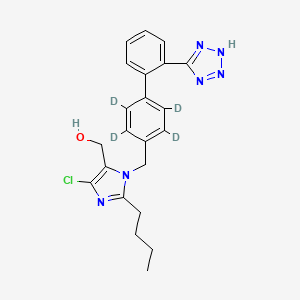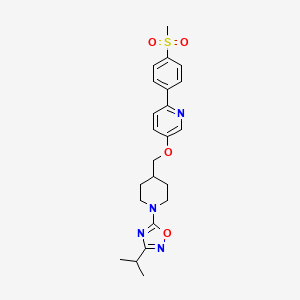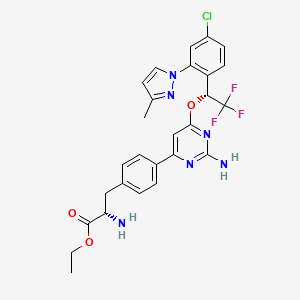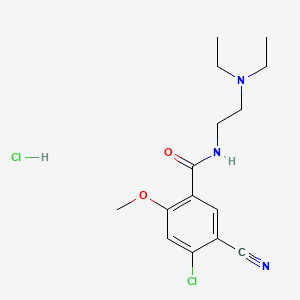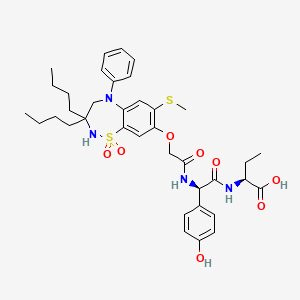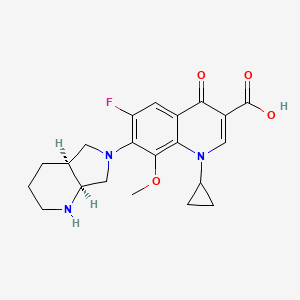
Moxifloxacin
Overview
Description
Moxifloxacin is a synthetic fluoroquinolone antibiotic used to treat a variety of bacterial infections. It is effective against both Gram-positive and Gram-negative bacteria. This compound is commonly used to treat respiratory tract infections, skin infections, and intra-abdominal infections. It is available in oral, intravenous, and ophthalmic formulations .
Mechanism of Action
Target of Action
Moxifloxacin, a synthetic fluoroquinolone antibiotic agent, primarily targets the enzymes topoisomerase II (DNA gyrase) and topoisomerase IV . These enzymes play a crucial role in bacterial DNA replication, transcription, and repair .
Mode of Action
This compound inhibits the activity of topoisomerase II and IV, which are essential for the synthesis of bacterial messenger RNA and DNA replication . By binding to these enzymes, this compound blocks the ability of bacteria to duplicate DNA , thereby inhibiting cell replication and leading to bacterial death .
Biochemical Pathways
This compound’s action affects several biochemical pathways. It has been found to inhibit cytokine-induced MAP kinase and NF-κB activation, as well as nitric oxide synthesis in a human respiratory epithelial cell line . Additionally, a targeted metabolomics study demonstrated that this compound induced liver injury affects pathways related to the biosynthesis of unsaturated fatty acids, glutathione metabolism, beta-alanine metabolism, one carbon pool by folate, and cysteine and methionine metabolism .
Pharmacokinetics
This compound exhibits high bioavailability (approximately 90%) and is rapidly absorbed in humans . The plasma half-life ranges between 11.4–15.2 hours depending on the dose given, indicating a once-daily treatment regimen . It is metabolized through glucuronide and sulfate conjugation . The drug is excreted in urine and feces , with good distribution to saliva, interstitial fluids, and lung tissues .
Result of Action
The bactericidal action of this compound results in the death of susceptible bacteria, making it effective against various bacterial infections . It is used to treat conditions such as sinusitis, pneumonia, secondary infections in chronic bronchitis, and bacterial conjunctivitis . Severe side effects may include spontaneous tendon ruptures, nerve damage, and worsening of myasthenia gravis .
Action Environment
The action of this compound can be influenced by various environmental factors. For instance, in vitro studies have shown that this compound killed S. pneumoniae and H. influenzae faster than other antibiotics like tobramycin and gentamicin . This suggests that the drug’s efficacy can vary depending on the specific bacterial environment. Additionally, the drug’s action may be affected by the patient’s health status and other individual factors .
Biochemical Analysis
Biochemical Properties
Moxifloxacin’s role in biochemical reactions primarily involves the inhibition of bacterial enzymes. It inhibits the enzymes topoisomerase II (DNA gyrase) and topoisomerase IV, which are essential for bacterial DNA replication and transcription . By inhibiting these enzymes, this compound prevents bacteria from duplicating their DNA, thereby stopping their growth and proliferation .
Cellular Effects
This compound has been shown to have significant effects on various types of cells and cellular processes. For instance, it has been found to inhibit the yeast to Hyphal morphogenesis by affecting signaling pathways . It also arrested the cell cycle of Candida albicans at the S phase . Moreover, it has been observed to have photostability and reduced phototoxicity on melanocytes .
Molecular Mechanism
The molecular mechanism of action of this compound involves its interaction with bacterial enzymes. It binds to and inhibits the activity of DNA gyrase and topoisomerase IV . These enzymes are responsible for maintaining the superhelical structure of DNA and are required for DNA replication and transcription, DNA repair, recombination, and transposition . By inhibiting these enzymes, this compound prevents the bacteria from duplicating their DNA, leading to their death .
Temporal Effects in Laboratory Settings
In laboratory settings, this compound has shown a dose-dependent reduction in bacterial density over time . It has been found to be the most effective among the four fluoroquinolones tested against penicillin-resistant streptococcal pneumonia in a mouse model . Moreover, it has been observed that this compound has a good stability profile, with no significant degradation over time .
Dosage Effects in Animal Models
In animal models, the effects of this compound have been observed to vary with different dosages. In rabbit models of meningitis, treatment with this compound resulted in a dose-dependent reduction in bacterial density . In a murine model of disseminated Mycobacterium tuberculosis infection, this compound was equivalent in its ability to prevent mortality and reduce the concentration of bacteria in spleens to other antibiotics tested .
Metabolic Pathways
This compound undergoes Phase II metabolism in humans, resulting in the formation of two main metabolites: N-sulphate (M1) and acylglucuronide (M2) . These metabolites are pharmacologically inactive . This compound is eliminated via metabolic, renal, and biliary/faecal routes .
Transport and Distribution
This compound is rapidly absorbed in humans, with a high bioavailability of approximately 90% . It has a good distribution to saliva, interstitial fluids, and lung tissues . About 22% of a this compound dose is excreted via the kidneys as unmetabolised this compound .
Preparation Methods
Synthetic Routes and Reaction Conditions: Moxifloxacin is synthesized through a multi-step process. The key steps involve the formation of the quinolone core, followed by the introduction of the cyclopropyl group, the methoxy group, and the diazabicyclononane moiety. The synthesis typically involves the following steps:
- Formation of the quinolone core through a condensation reaction between an aniline derivative and a β-ketoester.
- Introduction of the cyclopropyl group via a cyclopropanation reaction.
- Addition of the methoxy group through a nucleophilic substitution reaction.
- Formation of the diazabicyclononane moiety through a cyclization reaction .
Industrial Production Methods: Industrial production of this compound involves large-scale synthesis using optimized reaction conditions to ensure high yield and purity. The process includes:
- Use of high-purity starting materials and reagents.
- Optimization of reaction conditions such as temperature, pressure, and pH.
- Implementation of purification techniques such as crystallization and chromatography to obtain the final product .
Chemical Reactions Analysis
Types of Reactions: Moxifloxacin undergoes various chemical reactions, including:
Oxidation: this compound can be oxidized to form quinolone N-oxides.
Reduction: Reduction of this compound can lead to the formation of dihydroquinolone derivatives.
Substitution: Nucleophilic substitution reactions can occur at the methoxy group or the diazabicyclononane moiety
Common Reagents and Conditions:
Oxidation: Common oxidizing agents include hydrogen peroxide and potassium permanganate.
Reduction: Reducing agents such as sodium borohydride and lithium aluminum hydride are used.
Substitution: Nucleophiles such as amines and thiols are used in substitution reactions
Major Products:
Oxidation: Quinolone N-oxides.
Reduction: Dihydroquinolone derivatives.
Substitution: Amino or thio-substituted quinolone derivatives
Scientific Research Applications
Moxifloxacin has a wide range of scientific research applications:
Chemistry: Used as a model compound in studies of quinolone synthesis and reactivity.
Biology: Studied for its effects on bacterial DNA replication and repair mechanisms.
Medicine: Extensively researched for its efficacy in treating various bacterial infections, including respiratory tract infections, skin infections, and intra-abdominal infections.
Industry: Used in the development of new antibiotic formulations and drug delivery systems .
Comparison with Similar Compounds
- Ciprofloxacin
- Levofloxacin
- Ofloxacin
- Norfloxacin
Moxifloxacin’s unique properties, such as its broad spectrum of activity and excellent tissue penetration, make it a valuable antibiotic in the treatment of various bacterial infections.
Properties
IUPAC Name |
7-[(4aS,7aS)-1,2,3,4,4a,5,7,7a-octahydropyrrolo[3,4-b]pyridin-6-yl]-1-cyclopropyl-6-fluoro-8-methoxy-4-oxoquinoline-3-carboxylic acid | |
|---|---|---|
| Source | PubChem | |
| URL | https://pubchem.ncbi.nlm.nih.gov | |
| Description | Data deposited in or computed by PubChem | |
InChI |
InChI=1S/C21H24FN3O4/c1-29-20-17-13(19(26)14(21(27)28)9-25(17)12-4-5-12)7-15(22)18(20)24-8-11-3-2-6-23-16(11)10-24/h7,9,11-12,16,23H,2-6,8,10H2,1H3,(H,27,28)/t11-,16+/m0/s1 | |
| Source | PubChem | |
| URL | https://pubchem.ncbi.nlm.nih.gov | |
| Description | Data deposited in or computed by PubChem | |
InChI Key |
FABPRXSRWADJSP-MEDUHNTESA-N | |
| Source | PubChem | |
| URL | https://pubchem.ncbi.nlm.nih.gov | |
| Description | Data deposited in or computed by PubChem | |
Canonical SMILES |
COC1=C2C(=CC(=C1N3CC4CCCNC4C3)F)C(=O)C(=CN2C5CC5)C(=O)O | |
| Source | PubChem | |
| URL | https://pubchem.ncbi.nlm.nih.gov | |
| Description | Data deposited in or computed by PubChem | |
Isomeric SMILES |
COC1=C2C(=CC(=C1N3C[C@@H]4CCCN[C@@H]4C3)F)C(=O)C(=CN2C5CC5)C(=O)O | |
| Source | PubChem | |
| URL | https://pubchem.ncbi.nlm.nih.gov | |
| Description | Data deposited in or computed by PubChem | |
Molecular Formula |
C21H24FN3O4 | |
| Source | PubChem | |
| URL | https://pubchem.ncbi.nlm.nih.gov | |
| Description | Data deposited in or computed by PubChem | |
DSSTOX Substance ID |
DTXSID3048491 | |
| Record name | Moxifloxacin | |
| Source | EPA DSSTox | |
| URL | https://comptox.epa.gov/dashboard/DTXSID3048491 | |
| Description | DSSTox provides a high quality public chemistry resource for supporting improved predictive toxicology. | |
Molecular Weight |
401.4 g/mol | |
| Source | PubChem | |
| URL | https://pubchem.ncbi.nlm.nih.gov | |
| Description | Data deposited in or computed by PubChem | |
Physical Description |
Solid | |
| Record name | Moxifloxacin | |
| Source | Human Metabolome Database (HMDB) | |
| URL | http://www.hmdb.ca/metabolites/HMDB0014363 | |
| Description | The Human Metabolome Database (HMDB) is a freely available electronic database containing detailed information about small molecule metabolites found in the human body. | |
| Explanation | HMDB is offered to the public as a freely available resource. Use and re-distribution of the data, in whole or in part, for commercial purposes requires explicit permission of the authors and explicit acknowledgment of the source material (HMDB) and the original publication (see the HMDB citing page). We ask that users who download significant portions of the database cite the HMDB paper in any resulting publications. | |
Solubility |
1.68e-01 g/L | |
| Record name | Moxifloxacin | |
| Source | Human Metabolome Database (HMDB) | |
| URL | http://www.hmdb.ca/metabolites/HMDB0014363 | |
| Description | The Human Metabolome Database (HMDB) is a freely available electronic database containing detailed information about small molecule metabolites found in the human body. | |
| Explanation | HMDB is offered to the public as a freely available resource. Use and re-distribution of the data, in whole or in part, for commercial purposes requires explicit permission of the authors and explicit acknowledgment of the source material (HMDB) and the original publication (see the HMDB citing page). We ask that users who download significant portions of the database cite the HMDB paper in any resulting publications. | |
Mechanism of Action |
The bactericidal action of moxifloxacin results from inhibition of the enzymes topoisomerase II (DNA gyrase) and topoisomerase IV. DNA gyrase is an essential enzyme that is involved in the replication, transcription and repair of bacterial DNA. Topoisomerase IV is an enzyme known to play a key role in the partitioning of the chromosomal DNA during bacterial cell division., The fluoroquinolone antibiotic moxifloxacin has been associated with the acquired long QT syndrome and is used as a positive control in the evaluation of the QT-interval prolonging potential of new drugs. In common with other QT-prolonging agents, moxifloxacin is known to inhibit the hERG potassium K+ channel, but at present there is little mechanistic information available on this action. This study was conducted in order to characterise the inhibition of hERG current (I(hERG)) by moxifloxacin, and to determine the role in drug binding of the S6 aromatic amino-acid residues Tyr652 and Phe656. hERG currents were studied using whole-cell patch clamp (at room temperature and at 35-37 degrees C) in an HEK293 cell line stably expressing hERG channels. Moxifloxacin reversibly inhibited currents in a dose-dependent manner. We investigated the effects of different voltage commands to elicit hERG currents on moxifloxacin potency. Using a 'step-ramp' protocol, the IC50 was 65 uM at room temperature and 29 microM at 35 degrees C. When a ventricular action potential waveform was used to elicit currents, the IC50 was 114 microM. Block of hERG by moxifloxacin was found to be voltage-dependent, occurred rapidly and was independent of stimulation frequency. Mutagenesis of the S6 helix residue Phe656 to Ala failed to eliminate or reduce the moxifloxacin-mediated block whereas mutation of Tyr652 to Ala reduced moxifloxacin block by approximately 66%. Our data demonstrate that moxifloxacin blocks the hERG channel with a preference for the activated channel state. The Tyr652 but not Phe656 S6 residue is involved in moxifloxacin block of hERG, concordant with an interaction in the channel inner cavity., The bactericidal action of moxifloxacin results from inhibition of the topoisomerase II (DNA gyrase) and topoisomerase IV required for bacterial DNA replication, transcription, repair, and recombination. It appears that the C8-methoxy moiety contributes to enhanced activity and lower selection of resistant mutants of Gram-positive bacteria compared to the C8-H moiety. The presence of the bulky bicycloamine substituent at the C-7 position prevents active efflux, associated with the NorA or pmrA genes seen in certain Gram-positive bacteria., Torsade de pointes (TdP) is increasingly recognized as a complication of drug therapy. The most common cause of drug-induced QT prolongation is inhibition of the rapidly activating component of the delayed potassium current (I(Kr)). Moxifloxacin, a widely used fluoroquinolone, is a weak I(Kr) inhibitor and has been associated with QT prolongation., Fluoroquinolones prolong the QT interval by blocking voltage-gated potassium channels, especially the rapid component of the delayed rectifier potassium current I(Kr), expressed by HERG (the human ether-a-go-go-related gene). According to the available case reports and clinical studies, moxifloxacin carries the greatest risk of QT prolongation from all available quinolones in clinical practice and it should be used with caution in patients with predisposing factors for Torsades de pointes (TdP). | |
| Record name | Moxifloxacin | |
| Source | DrugBank | |
| URL | https://www.drugbank.ca/drugs/DB00218 | |
| Description | The DrugBank database is a unique bioinformatics and cheminformatics resource that combines detailed drug (i.e. chemical, pharmacological and pharmaceutical) data with comprehensive drug target (i.e. sequence, structure, and pathway) information. | |
| Explanation | Creative Common's Attribution-NonCommercial 4.0 International License (http://creativecommons.org/licenses/by-nc/4.0/legalcode) | |
| Record name | Moxifloxacin | |
| Source | Hazardous Substances Data Bank (HSDB) | |
| URL | https://pubchem.ncbi.nlm.nih.gov/source/hsdb/8026 | |
| Description | The Hazardous Substances Data Bank (HSDB) is a toxicology database that focuses on the toxicology of potentially hazardous chemicals. It provides information on human exposure, industrial hygiene, emergency handling procedures, environmental fate, regulatory requirements, nanomaterials, and related areas. The information in HSDB has been assessed by a Scientific Review Panel. | |
CAS No. |
151096-09-2, 354812-41-2 | |
| Record name | Moxifloxacin | |
| Source | CAS Common Chemistry | |
| URL | https://commonchemistry.cas.org/detail?cas_rn=151096-09-2 | |
| Description | CAS Common Chemistry is an open community resource for accessing chemical information. Nearly 500,000 chemical substances from CAS REGISTRY cover areas of community interest, including common and frequently regulated chemicals, and those relevant to high school and undergraduate chemistry classes. This chemical information, curated by our expert scientists, is provided in alignment with our mission as a division of the American Chemical Society. | |
| Explanation | The data from CAS Common Chemistry is provided under a CC-BY-NC 4.0 license, unless otherwise stated. | |
| Record name | Moxifloxacin [INN:BAN] | |
| Source | ChemIDplus | |
| URL | https://pubchem.ncbi.nlm.nih.gov/substance/?source=chemidplus&sourceid=0151096092 | |
| Description | ChemIDplus is a free, web search system that provides access to the structure and nomenclature authority files used for the identification of chemical substances cited in National Library of Medicine (NLM) databases, including the TOXNET system. | |
| Record name | Moxifloxacin | |
| Source | DrugBank | |
| URL | https://www.drugbank.ca/drugs/DB00218 | |
| Description | The DrugBank database is a unique bioinformatics and cheminformatics resource that combines detailed drug (i.e. chemical, pharmacological and pharmaceutical) data with comprehensive drug target (i.e. sequence, structure, and pathway) information. | |
| Explanation | Creative Common's Attribution-NonCommercial 4.0 International License (http://creativecommons.org/licenses/by-nc/4.0/legalcode) | |
| Record name | Moxifloxacin | |
| Source | EPA DSSTox | |
| URL | https://comptox.epa.gov/dashboard/DTXSID3048491 | |
| Description | DSSTox provides a high quality public chemistry resource for supporting improved predictive toxicology. | |
| Record name | 3-Quinolinecarboxylic acid, 1-cyclopropyl-6-fluoro-1,4-dihydro-8-methoxy-7-[(4aS,7aS)-octahydro-6H-pyrrolo[3,4-b]pyridin-6-yl]-4-oxo | |
| Source | European Chemicals Agency (ECHA) | |
| URL | https://echa.europa.eu/substance-information/-/substanceinfo/100.129.459 | |
| Description | The European Chemicals Agency (ECHA) is an agency of the European Union which is the driving force among regulatory authorities in implementing the EU's groundbreaking chemicals legislation for the benefit of human health and the environment as well as for innovation and competitiveness. | |
| Explanation | Use of the information, documents and data from the ECHA website is subject to the terms and conditions of this Legal Notice, and subject to other binding limitations provided for under applicable law, the information, documents and data made available on the ECHA website may be reproduced, distributed and/or used, totally or in part, for non-commercial purposes provided that ECHA is acknowledged as the source: "Source: European Chemicals Agency, http://echa.europa.eu/". Such acknowledgement must be included in each copy of the material. ECHA permits and encourages organisations and individuals to create links to the ECHA website under the following cumulative conditions: Links can only be made to webpages that provide a link to the Legal Notice page. | |
| Record name | MOXIFLOXACIN | |
| Source | FDA Global Substance Registration System (GSRS) | |
| URL | https://gsrs.ncats.nih.gov/ginas/app/beta/substances/U188XYD42P | |
| Description | The FDA Global Substance Registration System (GSRS) enables the efficient and accurate exchange of information on what substances are in regulated products. Instead of relying on names, which vary across regulatory domains, countries, and regions, the GSRS knowledge base makes it possible for substances to be defined by standardized, scientific descriptions. | |
| Explanation | Unless otherwise noted, the contents of the FDA website (www.fda.gov), both text and graphics, are not copyrighted. They are in the public domain and may be republished, reprinted and otherwise used freely by anyone without the need to obtain permission from FDA. Credit to the U.S. Food and Drug Administration as the source is appreciated but not required. | |
| Record name | Moxifloxacin | |
| Source | Hazardous Substances Data Bank (HSDB) | |
| URL | https://pubchem.ncbi.nlm.nih.gov/source/hsdb/8026 | |
| Description | The Hazardous Substances Data Bank (HSDB) is a toxicology database that focuses on the toxicology of potentially hazardous chemicals. It provides information on human exposure, industrial hygiene, emergency handling procedures, environmental fate, regulatory requirements, nanomaterials, and related areas. The information in HSDB has been assessed by a Scientific Review Panel. | |
| Record name | Moxifloxacin | |
| Source | Human Metabolome Database (HMDB) | |
| URL | http://www.hmdb.ca/metabolites/HMDB0014363 | |
| Description | The Human Metabolome Database (HMDB) is a freely available electronic database containing detailed information about small molecule metabolites found in the human body. | |
| Explanation | HMDB is offered to the public as a freely available resource. Use and re-distribution of the data, in whole or in part, for commercial purposes requires explicit permission of the authors and explicit acknowledgment of the source material (HMDB) and the original publication (see the HMDB citing page). We ask that users who download significant portions of the database cite the HMDB paper in any resulting publications. | |
Melting Point |
238-242 °C, 208-209 °C (decomposes), 238 - 242 °C | |
| Record name | Moxifloxacin | |
| Source | DrugBank | |
| URL | https://www.drugbank.ca/drugs/DB00218 | |
| Description | The DrugBank database is a unique bioinformatics and cheminformatics resource that combines detailed drug (i.e. chemical, pharmacological and pharmaceutical) data with comprehensive drug target (i.e. sequence, structure, and pathway) information. | |
| Explanation | Creative Common's Attribution-NonCommercial 4.0 International License (http://creativecommons.org/licenses/by-nc/4.0/legalcode) | |
| Record name | Moxifloxacin | |
| Source | Hazardous Substances Data Bank (HSDB) | |
| URL | https://pubchem.ncbi.nlm.nih.gov/source/hsdb/8026 | |
| Description | The Hazardous Substances Data Bank (HSDB) is a toxicology database that focuses on the toxicology of potentially hazardous chemicals. It provides information on human exposure, industrial hygiene, emergency handling procedures, environmental fate, regulatory requirements, nanomaterials, and related areas. The information in HSDB has been assessed by a Scientific Review Panel. | |
| Record name | Moxifloxacin | |
| Source | Human Metabolome Database (HMDB) | |
| URL | http://www.hmdb.ca/metabolites/HMDB0014363 | |
| Description | The Human Metabolome Database (HMDB) is a freely available electronic database containing detailed information about small molecule metabolites found in the human body. | |
| Explanation | HMDB is offered to the public as a freely available resource. Use and re-distribution of the data, in whole or in part, for commercial purposes requires explicit permission of the authors and explicit acknowledgment of the source material (HMDB) and the original publication (see the HMDB citing page). We ask that users who download significant portions of the database cite the HMDB paper in any resulting publications. | |
Retrosynthesis Analysis
AI-Powered Synthesis Planning: Our tool employs the Template_relevance Pistachio, Template_relevance Bkms_metabolic, Template_relevance Pistachio_ringbreaker, Template_relevance Reaxys, Template_relevance Reaxys_biocatalysis model, leveraging a vast database of chemical reactions to predict feasible synthetic routes.
One-Step Synthesis Focus: Specifically designed for one-step synthesis, it provides concise and direct routes for your target compounds, streamlining the synthesis process.
Accurate Predictions: Utilizing the extensive PISTACHIO, BKMS_METABOLIC, PISTACHIO_RINGBREAKER, REAXYS, REAXYS_BIOCATALYSIS database, our tool offers high-accuracy predictions, reflecting the latest in chemical research and data.
Strategy Settings
| Precursor scoring | Relevance Heuristic |
|---|---|
| Min. plausibility | 0.01 |
| Model | Template_relevance |
| Template Set | Pistachio/Bkms_metabolic/Pistachio_ringbreaker/Reaxys/Reaxys_biocatalysis |
| Top-N result to add to graph | 6 |
Feasible Synthetic Routes
Disclaimer and Information on In-Vitro Research Products
Please be aware that all articles and product information presented on BenchChem are intended solely for informational purposes. The products available for purchase on BenchChem are specifically designed for in-vitro studies, which are conducted outside of living organisms. In-vitro studies, derived from the Latin term "in glass," involve experiments performed in controlled laboratory settings using cells or tissues. It is important to note that these products are not categorized as medicines or drugs, and they have not received approval from the FDA for the prevention, treatment, or cure of any medical condition, ailment, or disease. We must emphasize that any form of bodily introduction of these products into humans or animals is strictly prohibited by law. It is essential to adhere to these guidelines to ensure compliance with legal and ethical standards in research and experimentation.



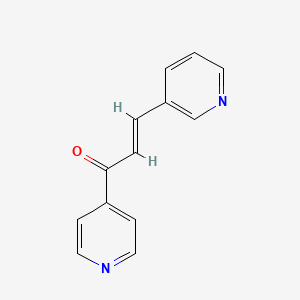

![[4-chloro-3-[5-methyl-3-[4-(2-pyrrolidin-1-ylethoxy)anilino]-1,2,4-benzotriazin-7-yl]phenyl] benzoate;hydrochloride](/img/structure/B1663545.png)
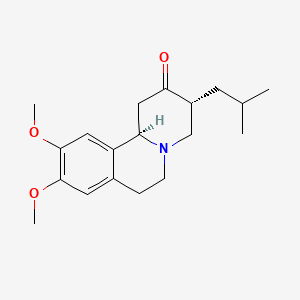
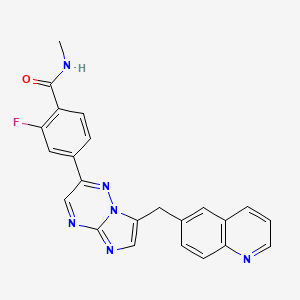
![2-[5-[3-[4-(2-bromo-5-fluorophenoxy)piperidin-1-yl]-1,2-oxazol-5-yl]tetrazol-2-yl]acetic acid](/img/structure/B1663549.png)
